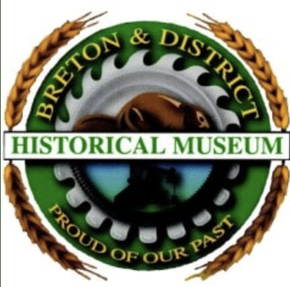Make Hay While the Sun Shines
By Allan Goddard
|
Last week was busy for me, as the old adage goes you need to make hay while the sun shines. Whenever I have trouble thinking of an interesting topic to write about, I turn to the archives of the Edmonton Journal and Edmonton Bulletin. I am amazed at the coverage many small communities, such as Breton, received from the Edmonton papers in years gone by.
Located just southeast of the Village of Breton, are the Breton Soil Plots operated by the University of Alberta. In 1929-30, the Breton Soils Plots were established by leasing 10 acres from the Ben Flesher family. The Department of Soil Science started to conduct experiments on fertilizers and crop rotations on “Gray Wooded Soils”. The scientific name is Gray Luvisol Soils, but more commonly called Gray Wooded Soils, due to the soil having a gray |
appearance when they were initially cleared and plowed. Gray Wooded Soils tend to be slightly acidic, have low soil fertility and are low in organic fiber. Early settlers found that although the land had an abundance of vegetation growing on in, and there was ample rainfall, within a few years of clearing and breaking the land their crops started to declined. Common farming practices of the day, used on the soils of the prairie, did not work on forested gray wooded soils. The productivity of agricultural crops in the area increased significantly over the next decades, due to the knowledge gained through experiments with the use of fertilizers, crop rotations and the addition of legumes to a rotation at the Breton Plots. As Elsie Flesher wrote in the Ladder of Time… “These plots could be said to be responsible for many of the histories recorded in this book: for without them, it is very doubtful if all those writing histories would still be in this “gray wooded soils” area to carry on a farming operation.”
A July 6,1949 news article in the Edmonton Journal was where I found my inspiration for this week’s museum article. The news headline read: “First Field Day on Clover Haying”. On the 8th of July there would be a demonstration on the haying of clover. It appears from the article that this demonstration was one of the first in western Canada. Several machinery companies were to be on hand to demonstrate their power mowers, side delivery rakes, hydraulic stackers, and square balers. The use of the latest in haying equipment would be demonstrated by the farm machinery dealers and discussed by agricultural engineers with attendees.
The program commenced at 10 AM, at the plots, located on the Flesher farm. The haying demonstration was held on the neighboring farm of Victor Hanson. In addition to the haying demonstration, there was to be information provided on the beneficial effects of various fertilizers on clover and grain crops grown.
The last sentence tells the difference between 1949 and 2022 … “Farmers and their wives are invited” … I didn’t realize that in 1949 farming was gender specific. Like the TV infomercials… wait there’s more. For the farm wives, Home Economist Miss Norma Smith of Wetaskiwin, and Miss Judson who specializes in home planning and interior decoration, will be on hand to discuss home problems. Gives a whole new meaning to “Date Night”.
Until next time make hay while the sun shines.
A July 6,1949 news article in the Edmonton Journal was where I found my inspiration for this week’s museum article. The news headline read: “First Field Day on Clover Haying”. On the 8th of July there would be a demonstration on the haying of clover. It appears from the article that this demonstration was one of the first in western Canada. Several machinery companies were to be on hand to demonstrate their power mowers, side delivery rakes, hydraulic stackers, and square balers. The use of the latest in haying equipment would be demonstrated by the farm machinery dealers and discussed by agricultural engineers with attendees.
The program commenced at 10 AM, at the plots, located on the Flesher farm. The haying demonstration was held on the neighboring farm of Victor Hanson. In addition to the haying demonstration, there was to be information provided on the beneficial effects of various fertilizers on clover and grain crops grown.
The last sentence tells the difference between 1949 and 2022 … “Farmers and their wives are invited” … I didn’t realize that in 1949 farming was gender specific. Like the TV infomercials… wait there’s more. For the farm wives, Home Economist Miss Norma Smith of Wetaskiwin, and Miss Judson who specializes in home planning and interior decoration, will be on hand to discuss home problems. Gives a whole new meaning to “Date Night”.
Until next time make hay while the sun shines.
|
Hours of Operation
11 AM - 5 PM Monday - Friday Call Allan at (780) 898-1155 to book a time. Admission by donation. |
Address: 4711-51 Street Breton, AB T0C 0P0




